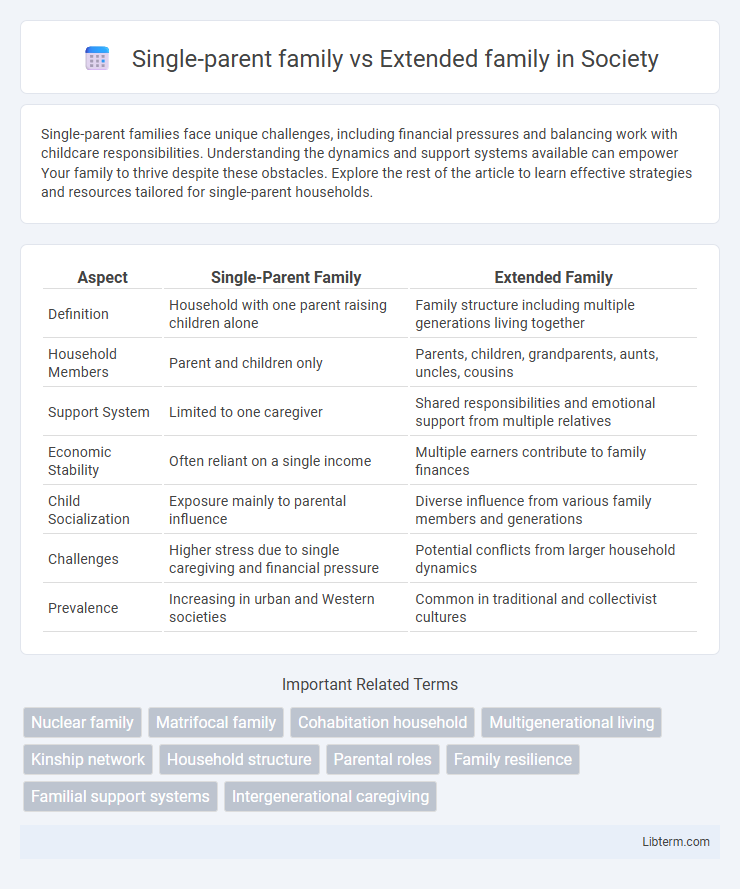Single-parent families face unique challenges, including financial pressures and balancing work with childcare responsibilities. Understanding the dynamics and support systems available can empower Your family to thrive despite these obstacles. Explore the rest of the article to learn effective strategies and resources tailored for single-parent households.
Table of Comparison
| Aspect | Single-Parent Family | Extended Family |
|---|---|---|
| Definition | Household with one parent raising children alone | Family structure including multiple generations living together |
| Household Members | Parent and children only | Parents, children, grandparents, aunts, uncles, cousins |
| Support System | Limited to one caregiver | Shared responsibilities and emotional support from multiple relatives |
| Economic Stability | Often reliant on a single income | Multiple earners contribute to family finances |
| Child Socialization | Exposure mainly to parental influence | Diverse influence from various family members and generations |
| Challenges | Higher stress due to single caregiving and financial pressure | Potential conflicts from larger household dynamics |
| Prevalence | Increasing in urban and Western societies | Common in traditional and collectivist cultures |
Definition of Single-Parent and Extended Families
A single-parent family consists of one adult raising one or more children without the presence of a partner, often due to separation, divorce, death, or choice. An extended family includes multiple generations living together or in close proximity, such as grandparents, aunts, uncles, and cousins, providing a broader network of support. These family structures differ significantly in composition, caregiving roles, and social dynamics.
Historical Context and Evolution
Single-parent families emerged prominently during industrialization as urbanization and economic shifts disrupted traditional household structures. Extended families, predominant in agrarian societies, provided social and economic support across generations, maintaining close-knit kinship networks. Over time, societal changes such as increased mobility, employment patterns, and cultural norms influenced the transition from extended family dominance to diverse family forms, including single-parent households.
Family Structure and Household Dynamics
Single-parent families typically consist of one adult caregiver raising children, leading to a more straightforward family structure but often increased economic and emotional responsibilities concentrated on one individual. Extended families include multiple generations or relatives living under one roof, creating complex household dynamics with shared roles, resources, and support systems. The presence of additional adults in extended families can distribute caregiving duties and contribute to social and financial stability, contrasting the often more isolated experience of single-parent households.
Emotional Support Systems
Single-parent families often face unique emotional challenges due to the concentrated responsibility of caregiving, which can lead to increased stress but also foster close, resilient bonds between parent and child. Extended families provide a broader emotional support system, distributing caregiving roles among multiple relatives, which can enhance a child's sense of security and social development. Research indicates children in extended families tend to experience greater emotional stability due to diverse interactions and availability of guidance from various family members.
Economic Challenges and Financial Stability
Single-parent families often face significant economic challenges due to relying on a single income, which limits financial stability and increases vulnerability to poverty. Extended families benefit from shared resources and pooled incomes, enhancing economic resilience and reducing individual financial burdens. Access to collective support networks in extended families can improve long-term financial security through shared housing costs, childcare, and employment opportunities.
Parenting Roles and Responsibilities
Single-parent families typically manage all parenting roles and responsibilities independently, requiring the sole parent to provide emotional support, financial stability, and discipline. Extended families distribute parenting duties among multiple relatives, allowing shared caregiving, guidance, and resource allocation, which can lessen the burden on any one individual. The collaborative environment in extended families often enhances socialization and cultural transmission for children while single-parent households may demand stronger time management and resilience from the solitary caregiver.
Impact on Child Development
Single-parent families often face economic and time constraints that can affect a child's emotional and academic development, increasing risks of behavioral challenges and lower educational attainment. Extended families provide a broader support network, contributing positively to social skills, emotional security, and cultural identity in children by sharing caregiving responsibilities and resources. Research indicates that the presence of multiple adult caregivers in extended families enhances resilience and coping mechanisms in children compared to single-parent households.
Social Connections and Community Involvement
Single-parent families often experience tighter-knit social connections within smaller networks, fostering close support systems despite limited resources. Extended families benefit from broader social ties and multigenerational involvement, enhancing community engagement through shared responsibilities and cultural traditions. Both family types contribute uniquely to social capital, influencing local social cohesion and collective participation.
Coping Mechanisms and Conflict Resolution
Single-parent families often develop streamlined coping mechanisms centered on clear communication and strong emotional support networks to manage daily stress and role overload. Extended families utilize diverse conflict resolution strategies, leveraging multiple adult perspectives and shared responsibilities to mediate disputes and maintain household harmony. Both family types benefit from resilience-building practices, though single-parent families rely more heavily on external social resources while extended families depend on internal collective problem-solving.
Advantages and Disadvantages of Each Family Type
Single-parent families often benefit from strong individual bonds and streamlined decision-making but may face financial strain and limited emotional support. Extended families provide a robust support network, shared resources, and diverse role models, yet can experience conflicts due to differing values and reduced privacy. Each family type impacts child development and well-being differently, influenced by economic stability, social dynamics, and cultural context.
Single-parent family Infographic

 libterm.com
libterm.com